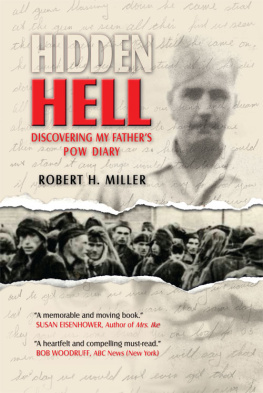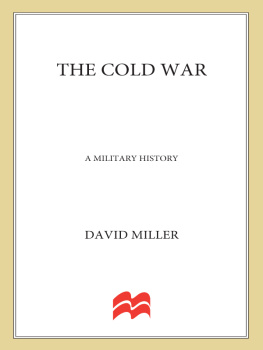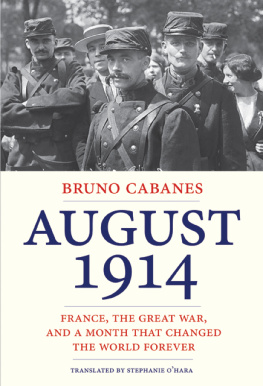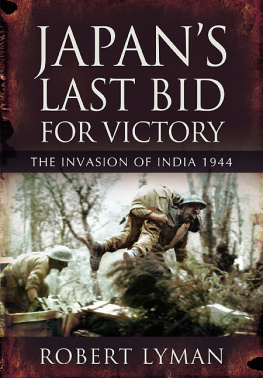Robert A. Miller - August 1944: The Campaign for France
Here you can read online Robert A. Miller - August 1944: The Campaign for France full text of the book (entire story) in english for free. Download pdf and epub, get meaning, cover and reviews about this ebook. year: 2013, publisher: Random House Publishing Group, genre: History. Description of the work, (preface) as well as reviews are available. Best literature library LitArk.com created for fans of good reading and offers a wide selection of genres:
Romance novel
Science fiction
Adventure
Detective
Science
History
Home and family
Prose
Art
Politics
Computer
Non-fiction
Religion
Business
Children
Humor
Choose a favorite category and find really read worthwhile books. Enjoy immersion in the world of imagination, feel the emotions of the characters or learn something new for yourself, make an fascinating discovery.

- Book:August 1944: The Campaign for France
- Author:
- Publisher:Random House Publishing Group
- Genre:
- Year:2013
- Rating:4 / 5
- Favourites:Add to favourites
- Your mark:
- 80
- 1
- 2
- 3
- 4
- 5
August 1944: The Campaign for France: summary, description and annotation
We offer to read an annotation, description, summary or preface (depends on what the author of the book "August 1944: The Campaign for France" wrote himself). If you haven't found the necessary information about the book — write in the comments, we will try to find it.
August 1944: The Campaign for France — read online for free the complete book (whole text) full work
Below is the text of the book, divided by pages. System saving the place of the last page read, allows you to conveniently read the book "August 1944: The Campaign for France" online for free, without having to search again every time where you left off. Put a bookmark, and you can go to the page where you finished reading at any time.
Font size:
Interval:
Bookmark:
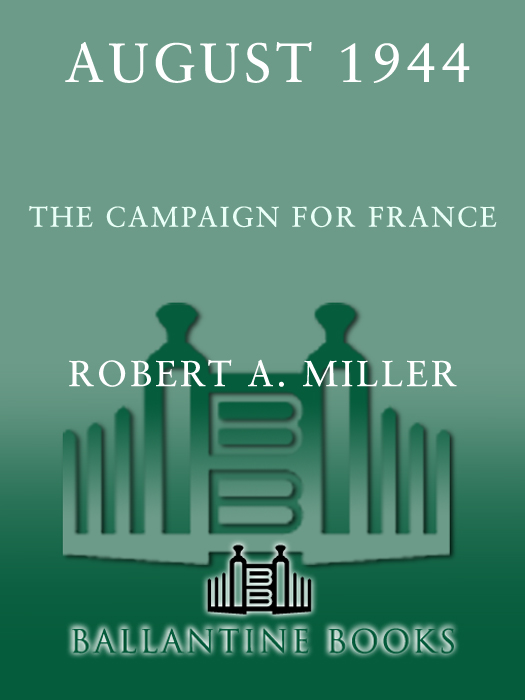
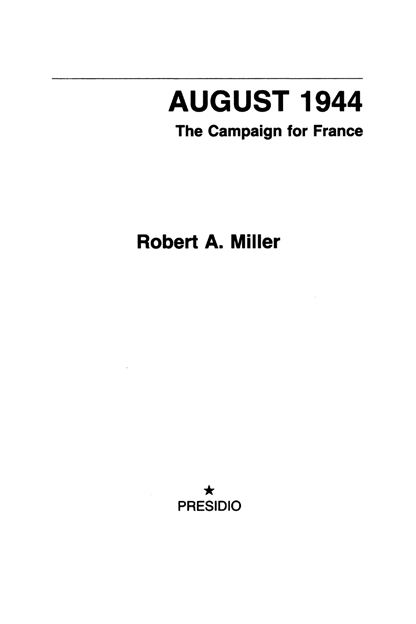
Copyright 1988 by Robert A. Miller
Published by Presidio Press
31 Pamaron Way, Novato, CA 94949
All rights reserved. No part of this book may be reproduced or utilized in any form or by any means, electronic or mechanical, including photocopying, recording or by any information storage and retrieval systems, without permission in writing from the Publisher. Inquiries should be addressed to Presidio Press, 31 Pamaron Way, Novato, CA 94949.
Library of Congress Cataloging-in-Publication Data
Miller, Robert A., 1921
August 1944.
Bibliography:
Includes index.
1. World War, 19391945CampaignsFrance
Chronology. I. Title.
D761.M55 1988 940.5421 8725829
eISBN: 978-0-307-82775-3
Photographs courtesy of the United States Military History Institute, Carlisle, Pennsylvania, with special thanks to Mr. James Enos, photographer, also of Carlisle.
v3.1
In the six years duration of the Second World War, numerous time periods or particular dates have been described by historians as critical to the outcome of the war. The spring of 1940, which saw the fall of France and the beginning of Nazi domination of the European continent, was one such period. The German invasion of Russia in June 1941 was another. The attack on Pearl Harbor and the Japanese sweep throughout the Pacific in late 1941 and early 1942 must certainly be considered a major influence on the progress of the war. Some historians have claimed that the Battle of Midway in June 1942 was a pivotal event, at least in the war between the United States and Japan. The period most frequently mentioned as the turning point in the fortunes of the various contestants has been the fall of 1942. The Russians successful defense of Stalingrad, the British victory at El Alamein, the American invasion of North Africa, and the Guadalcanal campaign in the South Pacific all occurred within a month or two of each other, and their combined influence on the course of the war was significant.
Another period deserves to take its place alongside these well-known moments in history. It is the month of August 1944. The Allied campaign in northern Europe, which began with the invasion of Normandy, sealed the fate of the Axis powers. More than any other campaign of the war, it was decisiveit tipped the scales between victory and defeat. Furthermore, it was through the hedgerows and across the plains of France during the month of August that the ultimate outcome of this crucial campaign was decided. The events of these thirty-one days had a major impact on the outcome of World War II.
As background to more fully appreciate the significance of these crucial days of August, it would be worthwhile to review briefly the story of the planning and development of the European campaign. It had a rather long and tortuous history, leading up to the climactic day when American, British, and Canadian troops stormed ashore on the beaches of Normandy. The story began just a few months after the Japanese attack on Pearl Harbor.
It is to be considered that the principal target for our first major offensive should be Germany, to be attacked through western Europe. This answer is based on the following reasons:
(1) It involves the shortest possible sea routes, thus placing a minimum strain upon shipping.
(2) No matter where our forces are employed, the lines of communication to England must be kept reasonably safe. Therefore, a theater in western Europe does not require a dispersion of escorting and other protective equipment, air and naval.
(3) An early beginning toward building up, in Great Britain, air and ground forces, and a forward base, will from the very beginning, carry a certain threat against Germany which should prevent complete concentration against Russia.
(4) Land communications for the invading force are superior to those to be found in any other area from which either enemy can be attacked.
(5) The forward base in England is already supplied with air fields from which a large air force can operate in order to gain, along the coast, the air superiority that is absolutely vital to a successful landing.
(6) The plan offers the only feasible method for employing offensively a major portion of the British combat power.
(7) It attempts to attack our principal enemy while he is engaged on several fronts; hence, speed in preparation is important.
The great objection to the plan is the difficulty of organizing, on the shores of western Europe, a force of sufficient strength to meet the hostile opposition that could be brought against it.
The success of the plan depends on the following:
a. Complete agreement among the Combined Chiefs of Staff that this constitutes our eventual task; and a determination to accomplish all the preparatory work demanded. Proper adjustment of training and production schedules.
b. Overwhelming air support.
c. Ample landing craft.
d. Ample shipping to support the operations from the beginning and to bring U.S. reinforcements rapidly into the theater.
e. Husbanding of combat powerto acquire the necessary strength, and avoid the evils of unjustified dispersion.
The above memorandum, dated March 25, 1942, was to Army Chief of Staff Gen. George C. Marshall from the Operations Division of the War Department. Formerly known as the War Plans Division, the Operations Division (OPD) was entrusted with broad powers to formulate worldwide strategy and direct military operations. This memorandum represented one of the earliest concrete proposals with respect to long-range military strategy since the attack on Pearl Harbor had brought the United States into active participation in the war. It highlighted two important concepts that were to serve as the basic foundation of American military policy throughout the war: the defeat of Germany was to receive priority over the war against Japan in the Pacific, and this defeat could be accomplished most effectively by a major invasion of the continent of western Europe. The author of the memorandum was the new commander of OPD, Brig. Gen. Dwight D. Eisenhower.
Marshall had lunch at the White House the day he received the memorandum. Along with the president, Secretary of the Army Henry Stimson, Secretary of the Navy Frank Knox, Adm. Ernest King, Gen. Hap Arnold, and Harry Hopkins were also present. Marshall presented the arguments in favor of an attack across the English Channel as outlined in Eisenhowers memo and received Roosevelts approval to proceed with the planning. Within a week, Marshall and Stimson were back at the White House with a final draft of the proposals, which received Roosevelts enthusiastic endorsement. Code name BOLERO, the plan called for the invasion of Europe in the summer of 1943 and included a subsidiary plan for a smaller landing in 1942, should events on the continent make such an operation appear feasible.
Marshall and Hopkins went to London in the middle of April in order to secure British support for the plan. At a late-night meeting at Chequers, Prime Minister Winston Churchill was the essence of cordiality Encouraged by this apparent support of the British allies, Marshall returned with orders for Eisenhower and OPD to put maximum effort into converting the plans into action. Then, at the end of May, he ordered Eisenhower to London to review the problems involved in building up sufficient forces for BOLERO. After a ten-day trip, Eisenhower returned with a recommendation that a position of commander of the European Theater of Operations (ETO) be established to organize, train, and command the American forces to be assigned to the theater. Marshall agreed and, after several days of consideration, appointed Eisenhower to the command.
Font size:
Interval:
Bookmark:
Similar books «August 1944: The Campaign for France»
Look at similar books to August 1944: The Campaign for France. We have selected literature similar in name and meaning in the hope of providing readers with more options to find new, interesting, not yet read works.
Discussion, reviews of the book August 1944: The Campaign for France and just readers' own opinions. Leave your comments, write what you think about the work, its meaning or the main characters. Specify what exactly you liked and what you didn't like, and why you think so.



